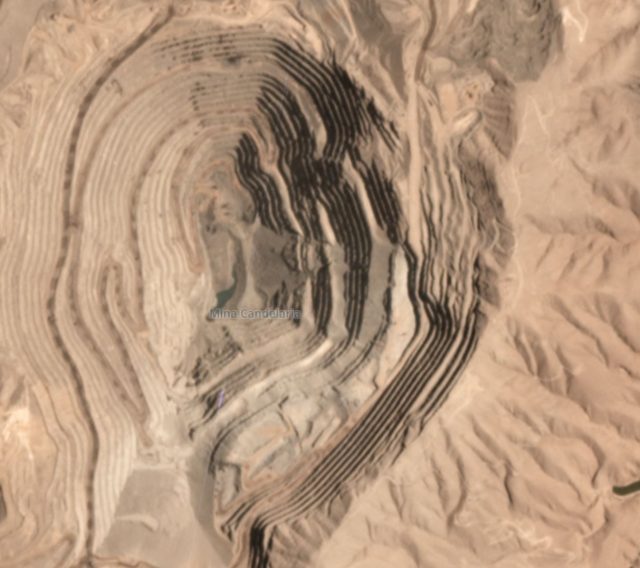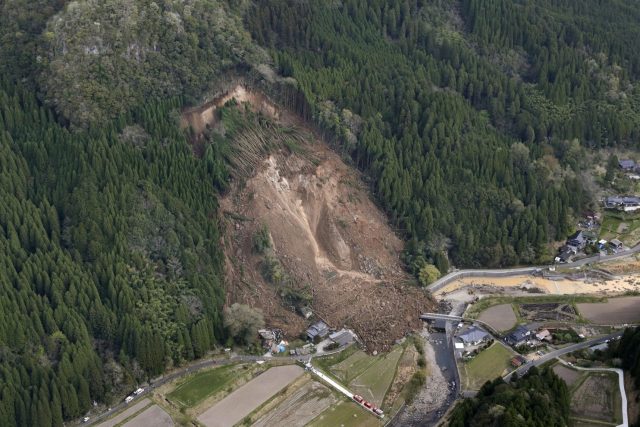12 April 2018
Candelaria mine: a large rockslide in October 2017
Posted by Dave Petley
Candelaria mine: a large rockslide in October 2017
The Candelaria mine is a large open-cast copper pit located in the Atacama region of northern Chile, and run by the Lundin Mining Corporation. Back in October 2017 this mine suffered a major rockslide that inhibited operations. In December 2017 the CEO of the company apologised to investors for the low level of communication around the rockslide. The share value of the parent company lost 16% of their value when it was revealed that production would be cut by 20%, although that has partially (not completely) recovered since.
The Globe and Mail article about this event provides some detail about the landslide:
“Phil Brumit, president and managing director of the Candelaria operations, said Lundin came upon a previously unseen and unmapped structure that led to a “wedge failure” at the mine site. Technicians saw movement in the affected area about 5 days before the slide happened. All personnel were then evacuated out of the area. During the slide, between six and seven hundred thousand tonnes of waste material slid into the pit floor. Now the company must devote some of its energy to clearing out the significant amounts of waste material and also ensuring the stability of that section of the mine.”
The landslide happened on 31st October 2017. This is a Planet Labs composite image from October 2017 showing the Candelaria mine. Note the bulging slope at the centre of the image on the eastern slope, extending from the pit bottom about half way up the slope:-

Planet Labs image of the Candelaria mine, collected in October 2017.
.
This is the same site, collected again by Planet Labs in November 2017:-

Planet Labs image of the Candelaria mine in the aftermath of the rockslide.
.
The significant wedge-shaped failure is clearly evident, as is the damage to the roads and the benches. However, once again this is a case in which the failure event was anticipated. The mining industry is extremely effective at monitoring slopes and detecting potential failures, ahead of the rest of the sector. There is a need to try to translate this expertise more widely. This need was tragically illustrated in Japan this week, when a large rockslope failure struck a number of houses, killing six people:-

The rockslide at Nakatsu, Oita Prefecture in Japan, which killed six people. Image via the Washington Post.
.
NHK has an article that explores the cause of this landslide:-
Geological experts say Wednesday’s deadly landslide in southwestern Japan was likely caused by weathering of the slope’s bedrock…At the land ministry’s request, a team of researchers from a Kyushu University graduate school inspected the site later in the day. The researchers found that the bedrock on the upper-most part of the slope has turned into whitish sand, due to weathering. The team says on top of a relatively solid layer of andesite is a softer layer of ignimbrite near the top of the slope. The upper layer is a pyroclastic flow deposit caused by a volcanic eruption between 900,000 and 1,000,000 years ago. The team says the slope collapsed because the weathering of the bedrock extended more than 10 meters below the surface.
Such a landslide would almost certainly show precursory deformation that could be detected with the technology used in the mining industry. The challenge for us all now is to work out how this might be practicable given the numbers of natural slopes that might be at risk.
Reference
Planet Team (2017). Planet Application Program Interface: In Space for Life on Earth. San Francisco, CA. https://api.planet.com


 Dave Petley is the Vice-Chancellor of the University of Hull in the United Kingdom. His blog provides commentary and analysis of landslide events occurring worldwide, including the landslides themselves, latest research, and conferences and meetings.
Dave Petley is the Vice-Chancellor of the University of Hull in the United Kingdom. His blog provides commentary and analysis of landslide events occurring worldwide, including the landslides themselves, latest research, and conferences and meetings.
David and Community — we are well prepared to address this opportunity and issues with anyone who is interested in making the sector more dynamic. In mining, if you look at the potential economic impacts —- managing slopes with products like our IBIS, HYDRA, and ArcSAR radar only make sense. The next step is actually sharing what they do, how well they and the site staff manage the data, and securing the pit asset.
On the civil side, we can engage a unit in a matter of hours across most of NA. We have analysts and professional certified staff to assist or do reporting for you, a phone call 303-726-6024, or email to me is all it takes. We will help anyone get this expertise in house too if you like.